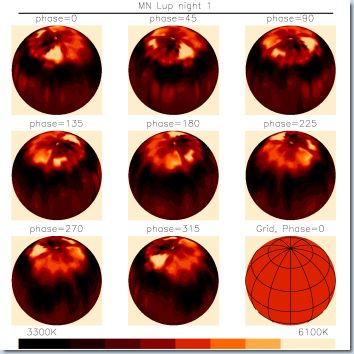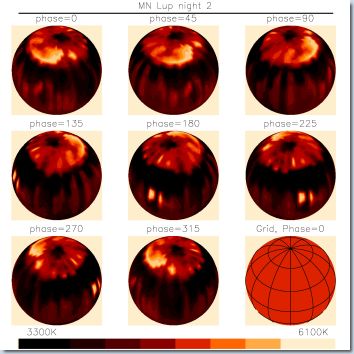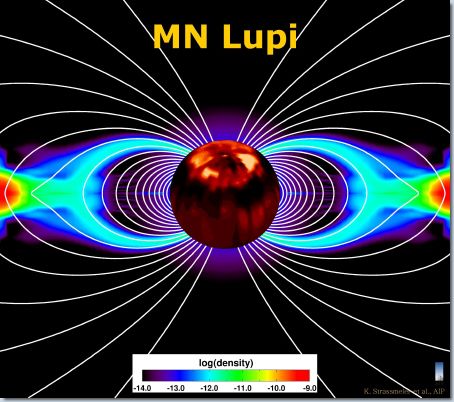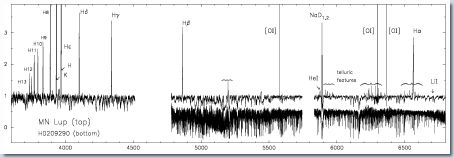|
Magnetospheric accretion impacts were detected on the surface of a young T Tauri star in the Lupus star forming region
For the first time, we have spatially resolved and mapped accretion impact regions on the surface of a T Tauri star. Some of these stars are known to have accretion disks out to many stellar radii that are being continuously accreted onto the surface of the host star until nothing remains. Material is already ripped off far above the stellar surface if a magnetic field is present and funnels its plasma along magnetic field lines onto the stellar surface. The impact happens predominantly near the polar regions, where the shock heats the atmosphere and produces a hot spot visible even in absorption spectral line profiles. Our observations show that accretion can occur even when no direct evidence for the presence of a disk is detected.
We obtained high-resolution, high-quality VLT/UVES spectra to reconstruct the two-dimensional surface structure of the rapidly rotating classical T-Tauri star MN Lupi on two separate nights. Both surface maps show a photospheric temperature of 3,800 K with a structured warm (5,000 K) band centered around the visible rotation pole at a latitude of 65°. Located within the band are two hot spots with temperatures of approximately or possibly even in excess of 5,800 K, i.e. 2,000 K above the effective photospheric temperature. Both maps appear with an adjacent equatorial band of temperature 3,400 K, some 400-500 K below the effective photospheric temperature.

Doppler image for all rotational phases for May 27, 2000

Doppler image for all rotational phases for May 28, 2000
|
|

Doppler image of MN Lupi and a model of the magnetic disk-star connection. The Doppler image shows temperature as a color code, from 3370 K (black) to 5800 K (bright yellow). The star-disk model shows poloidal field lines and color-coded density contours. The star has a rotation period of 10.5 hours.
While we interpret the two hot spots and the warm high-latitude band to be the heating points from two accretion impacts at the time of our observations and their redistributed energy trailed due to the fast stellar rotation, respectively, the cool equatorial band may not be cool after all but due to obscuration of the stellar surface by the innermost region of the disk. The fact that the hot spots appear at high stellar latitude is in agreement with the magnetospheric accretion model that proposes material funnelling onto the star along a predominantly dipolar magnetic field at roughly 50° latitude. The evidence of ongoing disk accretion, together with the very fast rotation of MN Lupi of just 3-4 times below its break-up velocity, suggests that the accretion mechanism is the cause of its rapid surface rotation. We present a model of magnetic star-disk coupling for MN Lupi that predicts a polar surface magnetic field of 3 kGauss.

Optical spectrum of MN Lup obtained with ESO's UVES.
|
Publication
Strassmeier K. G., Rice J. B., Ritter A., Küker M., Hussain G. A. J., Hubrig S., Shobbrook R.:
"Spatially resolving the accretion shocks on the rapidly rotating M0 T-Tauri star MN Lupi"
Astronomy & Astrophysics, in press
[Stellar Activity group]
[MHD group]
[AIP Homepage]
|


 last change 2005 July 15, R. Arlt
last change 2005 July 15, R. Arlt


